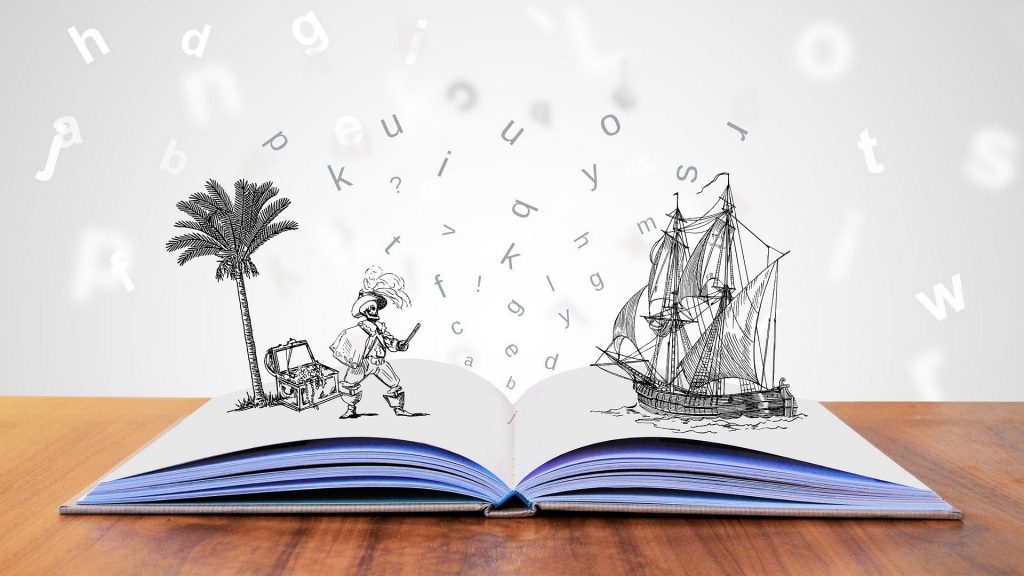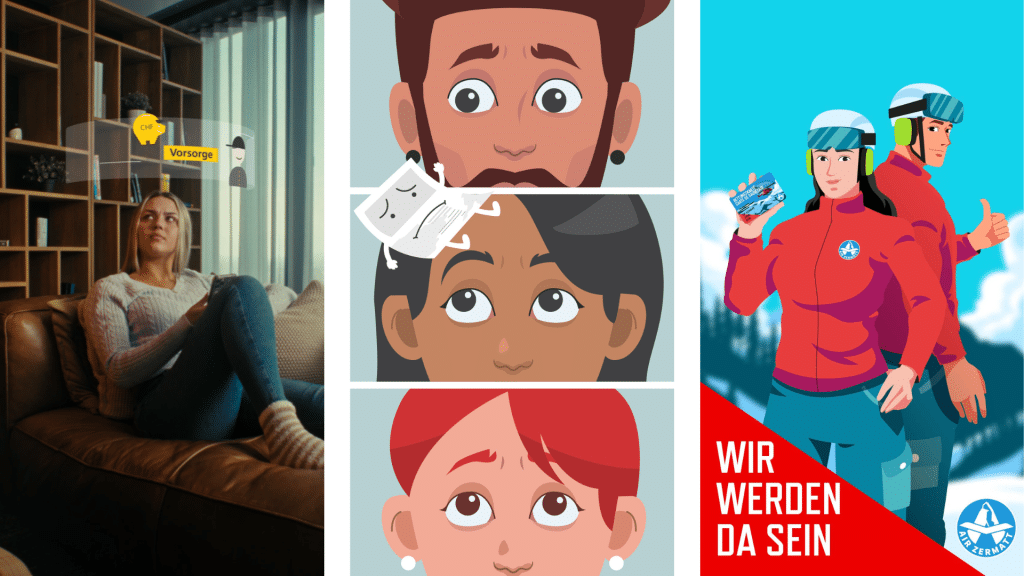Historically, storytelling can be traced back to the first stories people told each other in the moonlight by the crackle of a campfire. As time went on, however, not only did the stories become more elaborate, more captivating, and more and more embellished – the campfire gradually gave way as well. The tales were recorded in writing in literature, whether in novels or novellas. The first theaters presented with their performances the Storytelling into the center of entertainment society. And with the development of film technology, nowadays we find it in the cinema, on television and online on social media. As the metaverse continues to evolve, storytelling will also take on a new dimension – completely immersive for immersion.
Today, however, this storytelling technique is also one of the most most effective marketing toolsavailable to you – and mainly on the Internet. If you can use a story to connect emotionally with your audience and captivate them in ads, videos or podcasts, you’ll be able to increase your Captivate, inspire, amuse target group. And then a possible purchase decision will be much easier for them.
Now if you want to know how to make an explainer video with compelling storytelling, then you should definitely read this article.
Storytelling: What is Storytelling?
Storytelling is a communication tool that allows you to convey a message using a very unique stylistic device. It depends, pick up the audience and touch them emotionally by telling a story. However, this is not necessarily done in the sweeping style of a novel – after all, the relevant information is still to be very briefly be conveyed.
Storytelling is often used in advertising, corporate communications and in video marketing. The meaning behind it: It ensures that a emotional connection to your product, brand or company arises. This usually generates a very strong emotional response in the audience.

Structure and dramaturgy: the be-all and end-all of storytelling
When building a classic story, it is important that the plot has a clear beginninga middle part and an end has. This creates an arc of tension within a typical 3-act-scheme:
- Beginning: For good storytelling in marketing, the first thing is to create a Initial situation describe in more detail and create the initial situation. A special event then sets the actual plot in motion, the main character is about to embark on an adventure. Or to put it in Bilbo Baggin’s words, “I’m going on an adventure!”.
- center section: This is then replaced in the middle section by a Complication explained in more detail. The protagonist must resolve a conflict and often finds himself at his lowest point. At the same time, you should never lose the thread, so that the story remains exciting and coherent.
- End: In the third act, the protagonist now knows how to resolve and can change everything for the better. All the problems are out of the way and the resolution of the story leaves you with a good feeling, the happy ending.
Also important in storytelling is the Introduction of the characters (“protagonists”). This can be customers, a product, a company or other target groups. Tie also Moments of surprisethe so-called “Plot Twists“, one. They are what make a story exciting and interesting.
When it comes to dramaturgy, the important thing is, a common thread that runs through the plot. He keeps the audience engaged and Captures his attention.
You can achieve a good dramaturgy in storytelling, for example for a image film by creating creating suspense, unexpected twists and conflicts install. Make sure that the plot remains credible and comprehensible. The characters should be well developed and have a plausible motivation for their actions.
Examples: What is good storytelling?
As with any compelling story, storytelling for marketing or advertising is about a “journey of the hero“. So it’s about someone (or something) going on an adventurous journey to a specific target to reach. On his way he masters different challenges and learns important lessons. The story takes the reader or viewer on an emotional journey and keeps them riveted until the end.
From literature, for example, we know “The Little Prince” by Antoine de Saint-Exupéry, who achieved world fame through his profound and poetic storytelling. “The Lord of the Rings” by J. R. R. Tolkien is another example of a successful story that excels in its sophisticated and detailed storytelling. In marketing and advertising, there are now plenty of examples of how well gripping storytelling can work.
Example 1: Disneyland Paris and the little duck
In the video from Disneyland Paris, a little duckling discovers his world and finds a comic book. Namely, an edition of “Donald Duck”. It sees the pictures and wants to be like Donald. Then the little duckling flies into a storm together with his parents. It goes off the path, becomes unconscious. And when it wakes up, right in front of it appears – that’s right, Donald Duck! The latter takes the duckling with him to Disneyland.
In this short storytelling video, Disney Studios use their well-known emotional storytelling skills to evoke in the viewer a magical longing to visit Disneyland. Disney skillfully sets the Anthropomorphism to remind us of the childlike enthusiasm with the help of the little duckling.
Example 2: Rank Tan in my Bedroom
The video, released by Greenpeace Canada, is about a little orangutan who goes on a rampage in a little girl’s nursery and then tells her origin story. The story is told from the first-person perspective of the girl in the first part and from that of the orangutan in the second.
In an impressive way, the perspective of an orangutan on rainforest deforestation for human products is presented here in poem form. Through rhetorical means, a comparison of the life situation of the two protagonists is also created.
So the storytelling approach is something special here. Unlike in example 1, no linear story is told. The first part raises the question of why the orangutan is in the girl’s room. The second part is a flashback that brings the actual message of the video to the viewer in an emotional way.
Example 3: Barclaycard Festival and wrestling
This is an excellent example of how, when it comes to storytelling, the creative approach knows no bounds. In the two related videos on the YouTube channel. Barclaycard the two protagonists share their thoughts with the viewer. The couple is in different situations that reflect each partner’s desired location. From the first-person perspective, the respective protagonist describes to the viewer that he himself would rather be in another place and only endures the unique passions of his partner.
Barclaycard Festival – His perspective:
Barclaycard Festival – Your Perspective:
The special feature: Barclaycard is skilfully using the mirror storytelling one. In the first video, the setting is a visit to a wrestling arena, on which he is only for the sake of his wife. However, he describes that with the help of Barclaycard, he can easily get to his “happy place”, a music festival, in the future. The following is a dream sequence of this visit. This setting is again the starting point of the second video. Here the couple swap roles and she describes at the festival how she can attend the wrestling event in the future.
Each video describes the real situation of a protagonist, which is presented in the other video only as an escape of thoughts. The storytelling approach is used here specifically to evoke a longing for experiences in the viewer.
Advantages: Storytelling as part of your own marketing strategy
Storytelling works even better when those being addressed can participate. Storytelling is the most modern way to tell stories. The method first uses the usual content of storytelling. But then options are added to Motivate the audience to interact.
Storytelling, then, refers to the creation of stories that allow viewers to actively participate in shaping the plot.
One of the main goals here is to put the viewer in the position of, to make decisions. To subscribe to a newsletter, to make a purchase or even to influence the course of the story.
This is achieved in a number of ways. For example, through the use of Multiple choice options. Viewers can thus choose between storylines. Or simply with a quiz, a playful element or simply with a click on the CTA button (call-to-action button).
This way you can even create an interactive recruiting video that potential employees of your company are sure to enjoy looking at. And the Success rate should also be a lot higher than with a conventional job advertisement.
Hyper-trendy are stories that use the virtual reality technology be told. Here, the viewer is especially enabled to empathize with the story and react to the action. Dive into the metaverse and decide for yourself where to go in the fantasy world – this freedom will definitely be remembered by your audience. An immersive experience with lasting anchorage.
Storytelling has a lot of potential to really push your marketing. We explain the exact advantages below:
More trust thanks to storytelling
With stories you hit the emotions of your audience. You make them empathize, feel sympathy, and connect emotionally.
Interactive Stories reinforce this effect. Because they bring through the interaction another level of feeling into play. The user has the possibility to influence and decide something himself. That makes him proud, satisfied, happy – and creates trust in you and your brand.
Interactive stories also offer a vivid and lively way to communicate and acquire knowledge. Active participation in the action lets users better internalize what they have seen, read or heard.
Increased reach of your campaigns
Storytelling is eye-catching, user-friendly and, most importantly appeals above all to the play instinct of the viewer.. He sees an emotionally effective video while listening to the specially selected sound effects. By scrolling, filling in or clicking, he collaborates to keep the story going and reach a new level. The reward effect is triggered and the gamification principle is completed.
This means that the time your target audience spends on your website, for example, will automatically increase. This alone strengthens the identification with your brand, your product or your company enormously.
The same goes for your social media accounts. Yours Fans and followers identify with what your storytelling shows them. If they like it, they share it with their friends. And there goes your storytelling-created Product video viral.
Long-term advertising success
Basically, the audience is capricious and the Internet is an enormously fast-moving medium. What meets the taste of a large target group today may be completely out of date tomorrow.
An interactive story, however, can break this cycle in a positive way.
For example, if you create a story that is always a little different depending on the viewer’s reaction, with a little luck you’ll have a real long runner. Continuation stories work also excellent in this context. The audience is highly motivated to watch the content more often and longer. This strengthens brand loyalty.
This allows you to run an advertising or marketing campaign for a longer period of time with just one video, without the tension decreasing. That in turn saves you the time and money of having to produce new content over and over again.

Storytelling: The 4 best tips for compelling stories
Good storytellers are often very well paid professionals. But that doesn’t mean no one else can tell a compelling story. Because the genius of it is: Storytelling can be learned – you too! To do this, it’s best to look at a lot of content that uses storytelling elements. It doesn’t matter if it’s video content, an image only, or text.
Then just try to apply what you particularly like yourself. Swap the product advertised in the story for yours.
Next, try to find your own words.
And always remember: Even with storytelling, practice makes perfect!
Little by little, you’ll find that your stories become more and more understandable, smooth, and memorable. Of course you should Consistently adhere to the principles of storytelling.
To ensure that your story resonates well with your audience and strengthens your brand, product or company, consider the following four tips:
1. the story should reflect the brand
Just following a trend or aimlessly appealing to customers’ emotions usually doesn’t do any good. More importantly, that the story fits the company. The values and convictions of the “narrator”, his USP (“Unique Selling Point”) should be reflected. That’s why, when it comes to storytelling in marketing, it’s so important that the so-called brand tonality is maintained is maintained.
For example, it would be unbelievable if a fashion brand for young fashion explained in a serious voice that its hip shirts do not shrink in the washing machine. With products like these and this target group, it’s all about fun and the lifestyle, not about doing laundry correctly. Unless the self-deprecation is intentionally used to create the plot twist in the storytelling.
2. the story is about the target group (and not about the company!)
It may sound confusing at first glance, but it makes sense. Because ultimately, that’s what storytelling is all about, impress the customer – and not about showing what a great storyteller you are.
This also means that a good story is not simply a listing of the career of a person, a company or a product. Rather, you should tell what connects the company to the customers. How and why this or that product helps solve customers’ problems.
So it’s not you who is the hero, but the target person to whom the storytelling is directed. The target group should be able to recognize itself in the main character and identify with it.
If a car manufacturer only talked about how great, innovative, economical and environmentally friendly its latest model is, potential buyers would probably quickly get bored. The provider would most likely be perceived as showing off.
But if he shows them in an emotional story, that the buyers are innovative, economical and environmentally friendly because they buy the car, the customer is a hero. The image and lifestyle associated with the product are transported and thus sold.
3. the story addresses the emotions
A good story captivates the reader, viewer or listener from beginning to end. It’s almost like a compulsion to get the whole story.
You will succeed if you manage to hit the emotions of your target person. That can with a humorous story work just as well as with a warmhearted story. Tension may and should be built in – disappointment, love, fear, disgust, joy, sadness, surprise. Any feeling that serves to want to know the end of the story. In the end, we are all human beings and are shaped by emotions.
If you can pull this off with your storytelling, the audience will even experience happiness hormones poured out. And these lead to the fact that they automatically Have a good feeling when they see your product or brand again. An emotional, sustainable anchoring with your target group.
Imagine you’re one of many bakers in town. To promote your business and attract more customers, you want to post a video on social media. In which should be highlighted the specifics of your business.
Possibility 1: You make a video by standing behind the counter of your bakery or at the oven and telling how delicious your breads are. Of course, you also mention the healthy ingredients and praise the good old craftsmanship. You might even let your employees have their say, and if you’re smart, even a few enthusiastic customers.
So far, so good. But unfortunately, such a video would probably be pretty interchangeable.
Possibility 2: The video shows you standing in the bakery at the crack of dawn, baking breads and rolls. Then you take one of those fresh, still-steaming loaves, wrap it up, and head outside. It’s just getting daylight when you take your bread to an elderly single lady who can’t very well leave the house to go shopping. You put the bag with the bread in front of the door and ring the bell. The lady finds her gift, smells it, closes her eyes with pleasure and looks gratefully into the camera.
What do you think: Which video do you think would get more views and maybe even go viral?
3. the story addresses the emotions
It is usually the small everyday things that occupy us the most. To tell this one, it doesn’t have to be a bombastic “from dishwasher to millionaire” story.
It is much more important that the story is relevant to your target audience is. The topic should engage your customers, their Picking up on goals, wishes, needs or even problems.
Complexity is actually only a hindrance in a story. So find out what engages your target audience, what annoys them, delights them or what they want to achieve. If your product or service matches, you already have a strong foundation for your next story with storytelling.
Conclusion - Why does storytelling work so well?
Storytelling is not but it takes time and a lot of know-how.. It is about telling simple incidents in such a way that an emotionally gripping story with a beginning, main part and logical end is created (dramaturgy according to the 3-act scheme).
Then viewers – your potential customers – will be captivated by it and are often willing to share it with their friends. willing to share the content with their friends. The benefits here are universal and often work despite language barriers:
- People love stories – Complex issues are much more easily understood by most people in the form of a story.
- Images create emotionality – In addition to the story itself, images can make it easier to absorb and understand the message of a story. Moreover, images speak a universal language.
- Storytelling targets the wishes, problemsThe actual product recedes into the background, but is stored as a possible solution.
As a result, videos created with the elements of storytelling, for example, often go viral on social media.
If that’s a bit too much for you and you’d like to use your time elsewhere, we’ll be happy to do it for you. We’ll help you tell and execute your story in a way that your audience will love. Take to this with pleasure directly
Contact with us and let us apply storytelling to your marketing.

Schedule a free consultation with our video experts.
Together we simplify your communication.
Dustin Bättig | CEO
Photo Credits: Tumisu, Kelly Sikkema, Kumpan Electric



